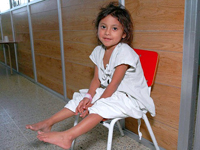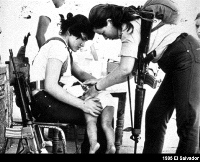Photo of the Week
- Details
 This girl smiles while she awaits her turn to receive tuberculosis treatment at a children's clinic in El Salvador. She had been suffering a respiratory illness that had passed undiagnosed for weeks. Health professionals finally discovered she was infected with TB and immediately began working together with her parents to provide her the Directly Observed Treatment (DOTS). The Global Plan to Stop TB encourages health care workers to implement the DOTS strategy to help stop tuberculosis and save millions of lives. Even today, 270,000 people every year become sick with TB, and 40,000 of the new cases are children.
This girl smiles while she awaits her turn to receive tuberculosis treatment at a children's clinic in El Salvador. She had been suffering a respiratory illness that had passed undiagnosed for weeks. Health professionals finally discovered she was infected with TB and immediately began working together with her parents to provide her the Directly Observed Treatment (DOTS). The Global Plan to Stop TB encourages health care workers to implement the DOTS strategy to help stop tuberculosis and save millions of lives. Even today, 270,000 people every year become sick with TB, and 40,000 of the new cases are children.
- Details
 Diocelina has already forgotten how many children she has helped to bring to the world. She may not know the numbers, but she does know about new life. As part of the network of midwives in Colombia, and over 80 years old, Diocelina continues to ensure the wellbeing of many pregnant women in communities where medicine does not reach for several reasons.
Diocelina has already forgotten how many children she has helped to bring to the world. She may not know the numbers, but she does know about new life. As part of the network of midwives in Colombia, and over 80 years old, Diocelina continues to ensure the wellbeing of many pregnant women in communities where medicine does not reach for several reasons.
- Details
 In 1985, guerrilla soldiers provide vaccination in El Salvador. During that time, the governments in the Americas create "Health: a bridge for peace," a model project enabling children to receive vaccinations while the guns fell silent. After months of negotiations in El Salvador, the President and opposition forces agreed to a temporary ceasefire to allow for immunizations. More than 20,000 people, including health workers, volunteers, and guerrilla forces, vaccinated the country's children.
In 1985, guerrilla soldiers provide vaccination in El Salvador. During that time, the governments in the Americas create "Health: a bridge for peace," a model project enabling children to receive vaccinations while the guns fell silent. After months of negotiations in El Salvador, the President and opposition forces agreed to a temporary ceasefire to allow for immunizations. More than 20,000 people, including health workers, volunteers, and guerrilla forces, vaccinated the country's children.
Read more: February 24, 2012 :: Health as a Bridge for Peace
- Details
 In 1954, doctors from Cuba, Dominican Republic, Nicaragua and other Member States collaborate during a training course in Mexico. The Region of the Americas boasts a long tradition of collaboration, recognizing the strength of the whole as well as the
diversity of individuals. Throughout PAHO's evolution, technical
cooperation in health remains rooted in uniting forces, sharing,
volunteering, contributing, and learning.
In 1954, doctors from Cuba, Dominican Republic, Nicaragua and other Member States collaborate during a training course in Mexico. The Region of the Americas boasts a long tradition of collaboration, recognizing the strength of the whole as well as the
diversity of individuals. Throughout PAHO's evolution, technical
cooperation in health remains rooted in uniting forces, sharing,
volunteering, contributing, and learning.
- Details
 Photo: Panamá 1913. "In the middle of difficulty lies opportunity," said Albert Einstein. At the dawn of the 20th century, plague, malaria, and yellow fever killed tens of thousands, threatening the future of such ambitious projects as the Panama Canal. Nonetheless optimism prevailed and drew the Americas together to meet new challenges. In 1902, recognizing that international efforts play a crucial role in the battle against disease, the International Sanitary Office was created, that has become the Pan American Sanitary Bureau, today PAHO's secretariat in Washington, D.C.
Photo: Panamá 1913. "In the middle of difficulty lies opportunity," said Albert Einstein. At the dawn of the 20th century, plague, malaria, and yellow fever killed tens of thousands, threatening the future of such ambitious projects as the Panama Canal. Nonetheless optimism prevailed and drew the Americas together to meet new challenges. In 1902, recognizing that international efforts play a crucial role in the battle against disease, the International Sanitary Office was created, that has become the Pan American Sanitary Bureau, today PAHO's secretariat in Washington, D.C.